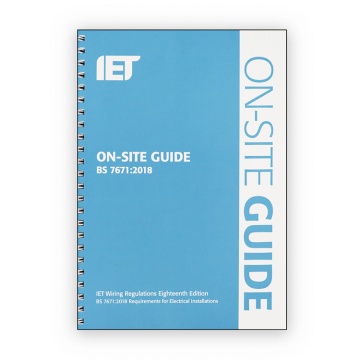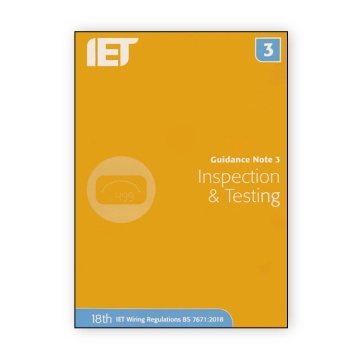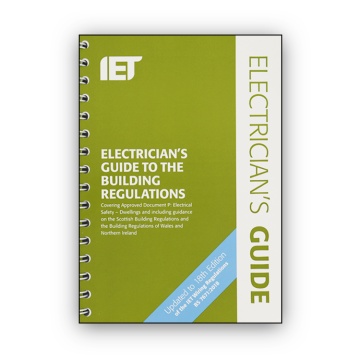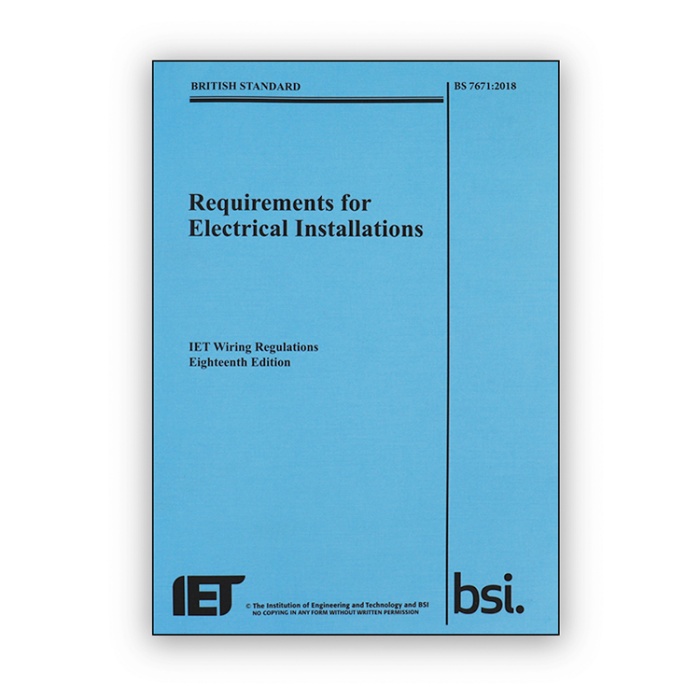
18th Edition BS 7671:2018 - Requirements for Electrical Installations, IET Wiring Regulations
The 18th Edition Wiring Regulations

BS 7671 (IET Wiring Regulations) sets the standards for electrical installation in the UK and many other countries. The IET co-publishes the Regulations with the British Standards Institution (BSI) and is the authority on electrical installation.
Following the guidance set out in BS 7671 is likely to ensure that your work meets the requirements of the Electricity at Work Regulations 1989.
The new 18th Edition Wiring Regulations (BS7671:2018) came into effect on 1st January, 2019. All new installations from this point must comply with BS 7671:2018
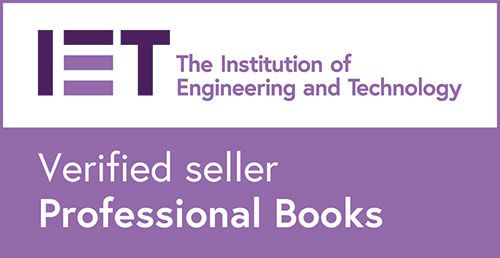 The IEE (Institution of Electrical Engineers) and the IIE (Institution of Incorporated Engineers) joined together in 2006 to form the IET (Institution of Engineering and Technology).
The IEE (Institution of Electrical Engineers) and the IIE (Institution of Incorporated Engineers) joined together in 2006 to form the IET (Institution of Engineering and Technology).
All titles published previously by the IEE and IIE are now published by the IET (where applicable)
IMPORTANT UPDATES!
BS 7671:2018 Corrigendum - Published Dec 2018
A corrigendum to BS 7671:2018 has been issued highlighting eleven corrections. Download a FREE PDF of the changes here »
BS 7671:2018 AMENDMENT 1 - Published Feb 2020
The amendment follows advances in technology that were not available when BS 7671:2018 published, enabling a more practical solution for the installation of charging points. Download a FREE PDF of the amendment here »
Significant changes
Protection against overvoltages
Geoff Cronshaw discussed the work being undertaken on this change in the Spring 2013 issue of Wiring Matters. I summarise the likely changes here.
Clause 443 is likely to be significantly revised based on the recently published IEC and CENELEC standard. However, the exact requirements will have to be agreed by the UK national committee. Assuming BS 7671 follows the IEC and CENELEC standard the AQ criteria (conditions of external influence for lightning) for determining if protection against transient overvoltage is needed would no longer be included in BS 7671. Instead, protection against transient overvoltage would have to be provided where the consequence caused by overvoltage affects:
- human life, e.g. safety services, medical care facilities;
- public services and cultural heritage, e.g. loss of public services, IT centres, museums; and
- commercial or industrial activity, e.g. hotels, banks, industries, commercial markets, farms.
For all other cases, a risk assessment would have to be performed in order to determine if protection against transient overvoltage is required. If the risk assessment is not performed, the electrical installation would have to be provided with protection against transient overvoltage.
However, an exception not to provide protection is included for single dwelling units where the total economic value of the electrical installation to be protected is less than 5 times the economic value of the SPD located at the origin of the installation.
Protection against switching overvoltages should still be considered.
Protection against fire
Protection against fire resulting from the electrical installation and the use of the electrical installation has been necessary ever since electricity was first introduced into buildings. Chapter 42 contains the requirements for the protection of persons, livestock and property against fire caused by electrical equipment, against burns and overheating and for including precautions where particular risks of fire exist.
It is recognised that RCDs can reduce the likelihood of fires associated with earth faults. However, whilst RCDs can detect earth faults they aren’t able to reduce the risk of electrical fire due to series or parallel arcing between live conductors because there is no leakage current to earth. Also, it is understood that the impedance of a series arc fault reduces the load current, which will keep the current below the tripping threshold of the circuit-breaker and the circuit-breaker may therefore not operate to disconnect the circuit.
For this reason details will be included in BS 7671:2018 for the installation of arc fault detection devices (AFDDs) to mitigate the risk of fire in final circuits of a fixed installation due to the effect of arc fault currents.
Changes to Section 753
The scope of Section 753 has been extended to apply to embedded electric heating systems for surface heating. They also apply to electric heating systems for de-icing or frost prevention or similar applications, and cover both indoor and outdoor systems. These include heating systems for walls, ceilings, floors, roofs, drainpipes, gutters, pipes, stairs, roadways and non-hardened compacted areas (for example, football fields, lawns). Heating systems for industrial and commercial applications complying with IEC 60519 and IEC 62395 are not covered. The IEC standard covers issues such as surface temperatures and refers the reader to the appropriate IEC guide.
Documentation is also covered. The designer will be required to provide appropriate information about approved substances in the surroundings of the heating units. For wall heating systems (which are more vulnerable than floors and ceilings from penetration) the standard contains additional requirements to protect against the effects of overheating caused by a short-circuit between live conductors due to penetration of an embedded heating unit. In the case of heating units that are delivered from the manufacturer without an earthed conductive shield, a suitable conductive covering, for example, a mesh metallic grid, with a mesh size of not more than 3 mm for wall installations, shall be provided on site and connected to the protective conductor of the electrical installation. In addition, the IEC standard requires that electric heating systems shall be selected and erected so as to avoid any harmful influence between the heating system and any electrical or non-electrical installations envisaged.
New section - energy efficiency
The worldwide need to reduce the consumption of energy means that we have to consider how electrical installations can provide the required level of service and safety for the lowest electrical consumption. The draft proposals enable a client to specify the level of energy efficiency measures applied to an electrical installation. Installations can also be awarded points for energy efficiency performance levels, for example, transformer efficiency. These points can be added together with points for efficiency measures to give an electrical installation an efficiency class, ranging from EIEC0 to EIEC4, depending on the number of points awarded.
The new section will cover several energy efficient areas, such as electric vehicles, lighting, metering, cable losses, transformer losses, power-factor correction, and harmonics.
| ISBN | 9781785611704 |
|---|---|
| Publication Status | Out Of Print |
| Publication Date | 2021-07-02 |
| Author | IET |
| Edition | 18th Edition |
| Format (Paperback, Hardback etc) | Paperback |
| Brand / Publisher | IET |
| Publisher | BSI & IET |
We offer customers a wide range of delivery options from Free (7-10 working days) ... right up to by Next Day by 9am (subject to location and stock availability).
- Simply choose your preferred service when checking out
- We show "live" stock levels for all publications
- Orders received after 3:45pm will be processed on the next working day.
- Unless specifically requested, our delivery partners will not attempt a weekend delivery
We offer all customers a "No Quibble" 28 day returns policy.
If you need to return a title for any reason ...
- Contact our customer services team first to explain what you are returning and the reason
- Request a Returns Authorisation Number
- We will email you this and a link to arrange your return quickly & easily via Royal Mail
- Take your return to your nearest Post Office and they will do the rest
Please refer to our Returns page for full details & charges.

